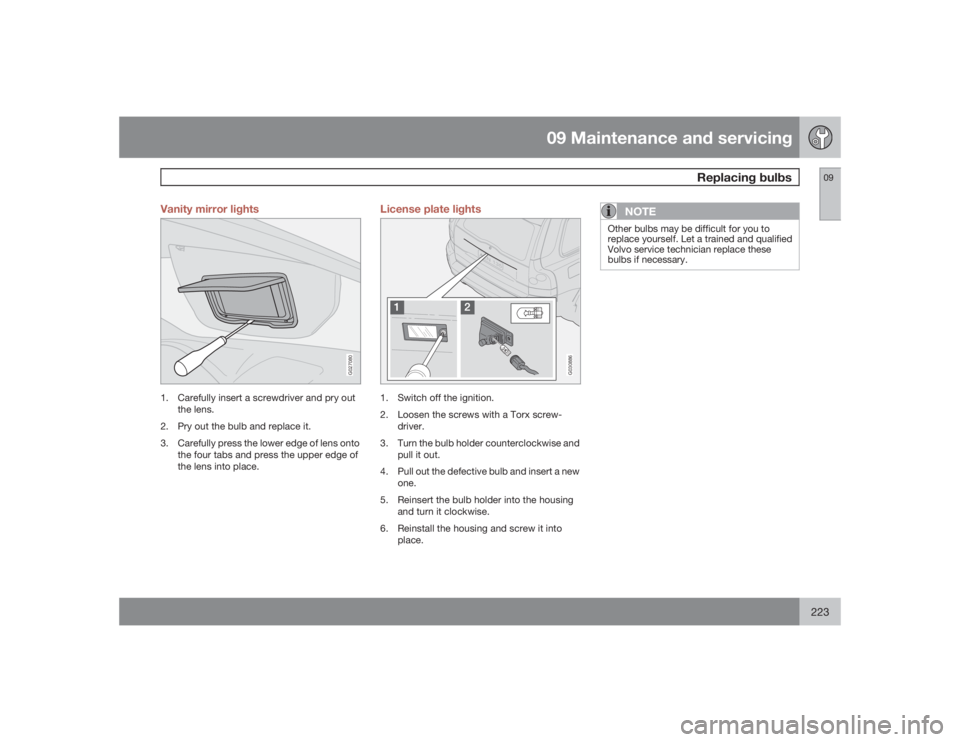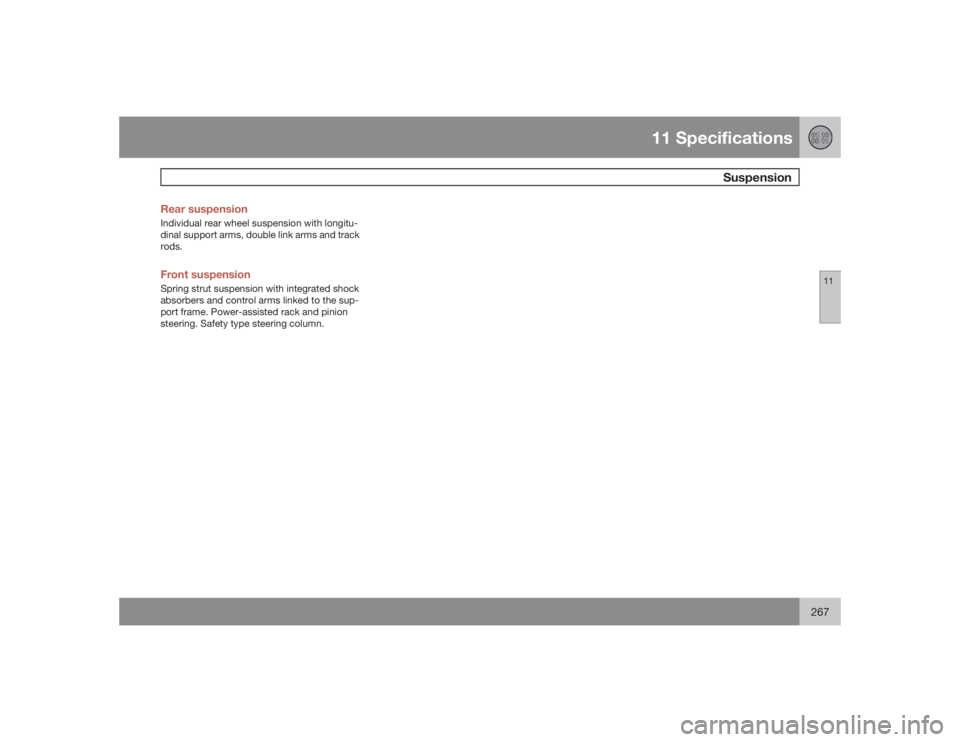2009 VOLVO XC90 ABS
[x] Cancel search: ABSPage 150 of 282

06 Starting and drivingTowing
06150
CAUTION
Vehicles with AWD (All Wheel Drive) with the
front wheels off the ground should not be
towed at speeds about 50 mph (70 km/h) or
for distances longer than 30 miles (50 km).
CAUTION
•
Please check with state and local
authorities before attempting this type
of towing, as vehicles being towed are
subject to regulations regarding maxi-
mum towing speed, length and type of
towing device, lighting, etc.
•
If the vehicle's battery is dead, do not
attempt to start the vehicle by pushing
or pulling it as this will damage the
three-way catalytic converter(s). The
engine must be jump started using an
auxiliary battery (see page 141).
•
If the vehicle is being towed on a flat bed
truck, the towing eyelets must not be
used to secure the vehicle on the flat
bed. Consult the tow truck operator.
WARNING
•
Remember that the power brakes and
power steering will not function when
engine is not running. The braking and
steering systems will function but the
brake pedal pressure required is
3 – 4 times above normal and greater
steering effort must be exerted.
•
The towing eyelets must not be used for
pulling another vehicle out of a ditch or
for any similar purpose involving severe
strain.
•
Do not use the towing eyelets to pull the
vehicle up onto a flat bed tow truck.
G030862
Towing vehicles with front wheel drive/
All Wheel DriveVolvo recommends the use of flat bed equip-
ment.
If wheel lift equipment must be used, please
use extreme caution to help avoid damage to
the vehicle. In this case, the vehicle should
be towed with the rear wheels on the ground
if at all possible.
If it is absolutely necessary to tow the vehicle
with the front wheels on the ground, please
refer to the towing information on the previous
page.
CAUTION
•
Sling-type equipment applied at the
front will damage radiator and air con-
ditioning lines.
•
It is equally important not to use sling-
type equipment at the rear or apply lift-
ing equipment inside the rear wheels;
serious damage to the rear axle may
result.
•
If the vehicle is being towed on a flat bed
truck, the towing eyelets must not be
used to secure the vehicle on the flat
bed. Consult the tow truck operator.
Page 152 of 282

06 Starting and drivingTowing a trailer
06152
NOTE
•
Recommended hitch tongue load:
not more than 10% of the trailer's
weight. The trailer load should be posi-
tioned so that it does not shift and the
tongue load should be 10% of the trail-
er's weight. However, the tongue load
should not exceed the maximum per-
missible weights indicated in the table
above.
•
When towing trailers without brakes,
the maximum permissible trailer weight
is 1,700 lbs (750 kg).
•
If necessary, redistribute the weight of
any cargo in the trailer to avoid exces-
sive weight on the trailer hitch.
•
The maximum trailer weight listed in the
table for All Wheel Drive models,
5,000 lbs (2250 kg) is only applicable
when there are not more than two occu-
pants in the vehicle, in the front seats,
with a combined weight of 300 lbs
(135 kg), with no other cargo in the vehi-
cle.
•
The maximum weight listed for Front
Wheel Drive models, 4,000 lbs (1800 kg)
is only applicable when there are not
more than four occupants in the vehicle,
in the front seats and second row of
seats, with a combined weight of
600 lbs (270 kg), with no other cargo in
the vehicle.
NOTE
•
Vehicles used for towing a trailer on a
regular basis, or for long-distance high-
way towing should be equipped with an
automatic transmission oil cooler and
Volvo's automatic self-leveling system
for the rear suspension. Consult your
Volvo retailer.
•
Volvo recommends the use of Volvo
trailer hitches that are specially
designed for the vehicle.
•
All Volvo models are equipped with
energy-absorbing shock-mounted
bumpers. Trailer hitch installation
should not interfere with the proper
operation of this bumper system.
•
Increase tire pressure to recommended
full inflation pressure. See chapter
"Wheels and tires."
•
When your vehicle is new, avoid towing
heavy trailers during the first 620 miles
(1,000 km).
•
Engine and transmission are subject to
increased loads. Therefore, engine
coolant temperature should be closely
watched when driving in hot climates or
hilly terrain. Use a lower gear and turn
off the air conditioner if the temperature
gauge needle enters the red range.
Page 196 of 282

08 Car careWashing and cleaning the vehicle
08196
CAUTION
Volvo does not recommend the use of long-
life or durable paint protection coatings,
some of which may claim to prevent pitting,
fading, oxidation, etc. These coatings have
not been tested by Volvo for compatibility
with your vehicle's clear coat. Some of them
may cause the clear coat to soften, crack,
or cloud. Damage caused by application of
paint protection coatings may not be cov-
ered under your vehicle's paint warranty.Mirrors with the water repellent glass
coating•
Do not apply wax, degreasing agents, etc
to this glass. This could damage the coa-
ting.
•
Clean the glass surface with care to avoid
scratching.NOTE
The water repellent coating is subject to
natural wear•
In order to maintain the coating's water
repellent characteristics, it should be trea-ted with a special compound that is avail-
able at your Volvo retailer.
•
This treatment should be carried out for the
first time after three years, and thereafter
once a year.
Cleaning the upholsteryFabricClean with soapy water or a detergent. For
more difficult spots caused by oil, ice cream,
shoe polish, grease, etc., use a clothing/fabric
stain remover. Consult your Volvo retailer.Interior plastic componentsCleaning interior plastic components should
be done with a cleaning agent specially
designed for this purpose. Consult your Volvo
retailer.Alcantera™ suede-like materialSuede-like upholstery can be cleaned with a
soft cloth and mild soap solution.Leather careVolvo's leather upholstery is manufactured
with a protectant to repel soiling. Over time,
sunlight, grease and dirt can break down the
protection. Staining, cracking, scuffing, and
fading can result.
Volvo offers an easy-to-use, non-greasy
leather care kit formulated to clean and beau-tify your vehicle's leather, and to renew the
protective qualities of its finish. The cleaner
removes dirt and oil buildup. The light cream
protectant restores a barrier against soil and
sunlight.
Volvo also offers a special leather softener that
should be applied after the cleaner and pro-
tectant. It leaves leather soft and smooth, and
reduces friction between leather and other fin-
ishes in the vehicle.
Volvo recommends cleaning, protecting and
conditioning your vehicle's leather two to four
times a year. Ask your Volvo retailer about
Leather Care Kit 951 0251 and Leather Soft-
ener 943 7429.
Cleaning leather upholstery1. Pour leather cleaner on a damp sponge
and squeeze it until the cleaner foams.
2. Apply the foam to the stain by moving the
sponge with circular movements.
3. Dampen the stain thoroughly with the
sponge. Let the sponge absorb the stain,
do not rub.
4. Dry the stain with soft paper towels or a
towel, and allow the leather to dry com-
pletely.
Page 223 of 282

09 Maintenance and servicing
Replacing bulbs
09
223 Vanity mirror lights
G027080
1. Carefully insert a screwdriver and pry out
the lens.
2. Pry out the bulb and replace it.
3. Carefully press the lower edge of lens onto
the four tabs and press the upper edge of
the lens into place.
License plate lights
G030886
1. Switch off the ignition.
2. Loosen the screws with a Torx screw-
driver.
3. Turn the bulb holder counterclockwise and
pull it out.
4. Pull out the defective bulb and insert a new
one.
5. Reinsert the bulb holder into the housing
and turn it clockwise.
6. Reinstall the housing and screw it into
place.
NOTE
Other bulbs may be difficult for you to
replace yourself. Let a trained and qualified
Volvo service technician replace these
bulbs if necessary.
Page 225 of 282

09 Maintenance and servicing
Fuses
09�`�`225 Fuses in the engine compartment
G026972
When replacing fuses, be sure to replace a
blown fuse with a new one of the same color
and amperage (written on the fuse).No
A
1
ABS
30
2
ABS
30
3
Headlight washers
35
4
–
20
5
Auxiliary lights (option)
35
No
A
6
Starter motor relay
25
7
Windshield wipers
15
8
Fuel pump
15
9
Transmission control module
(V8 and 6-cyl.)
15
10
Ignition coils, engine control
module
20
11
Throttle pedal sensor, A/C
compressor, e-box fan
10
No
A
12
Engine control module, fuel
injectors, mass airflow sensor
15
13
Throttle control (V8), Intake
manifold actuator (6-cyl.)
10
14
Heated oxygen sensor
20
15
Crankcase ventilation, sole-
noid valves, A/C connection,
leakage diagnostics, engine
control module (V8, 6-cyl.),
mass airflow sensor (V8)
15
Page 229 of 282

09 Maintenance and servicing
Fuses
09�`�`229 Fuse box in the passenger compartment, behind the plastic cover, driver's side
G028412
This fuse box is located behind the plastic
cover below the steering wheel. When replac-
ing a blown fuse, be sure to replace it with a
new one of the same color and amperage (writ-
ten on the fuse).No
A
1
Heated passenger's seat
15
2
Heated driver's seat
15
3
Horn
15
4
–
No
A
5
Audio system
10
6
–
7
–
8
Alarm siren (option)
5
9
Break light switch feed
5
10
Instrument panel, climate sys-
tem, power driver's seat,
Occupant Weight Sensor
10
No
A
11
12-volt sockets – front and rear
seats
15
12
–
13
–
14
–
15
ABS, DSTC
5
16
Power steering, Active Bi-
Xenon headlights (option)
10
Page 267 of 282

11 Specifications
Suspension
11
267 Rear suspension
Individual rear wheel suspension with longitu-
dinal support arms, double link arms and track
rods.Front suspensionSpring strut suspension with integrated shock
absorbers and control arms linked to the sup-
port frame. Power-assisted rack and pinion
steering. Safety type steering column.
Page 274 of 282

12 Index
12274
1, 2, 3 ...12-volt sockets.......................................... 75AA/C (air conditioning)...........................93, 94
ABS.......................................................... 143
Active Bi-Xenon headlights (ABL)........60, 64
Airbag system............................................ 20
Air cleaner................................................ 207
Air conditioning.......................................... 90
Air distribution...................................... 92, 94
Air quality sensor....................................... 93
Air vents..................................................... 92
Alarm........................................................ 125
All Wheel Drive......................................... 142
All Wheel Drive – towing.......................... 150
Anti-lock brake system
warning light......................................... 56
Anti-lock Brake System (ABS)................. 143
Ashtray..................................................... 109Audio
system introduction............................ 236
Audio system
Rear seat entertainment (option)........ 253
AUTO (climate control)......................... 94, 95
Automatic transmission........................... 138
Autostart..........................................133, 135
AUX (audio system).................................248
Average speed........................................... 71
AWD......................................................... 142
BBass......................................................... 239
Battery..................................................... 205
maintenance....................................... 214
specifications...................................... 270
Battery – replacing................................... 215
Belt check................................................ 206
Black Box (Vehicle Event Data)............... 202
Blind Spot Information System (BLIS)..... 159
Blower (fan)................................................ 95Booster cushion
accessory............................................. 42
integrated.............................................. 47
Brake fluid................................................ 212
Brake system........................................... 143
Bulbs........................................................ 217
Bulbs, replacing....................................... 217
CCapacities, fluids..................................... 265
Capacity weight....................................... 175
Cargo area cover..................................... 115
Cargo grid................................................ 114
Cargo net................................................. 112
Catalytic converter, three-way................. 272
CD Pause................................................. 249
Central locking system - remote control. 119
Changing a wheel.................................... 182
Changing coolant..................................... 206
Charge air cooler..................................... 269
Check Engine warning light....................... 57
Child restraint anchors......................... 43, 45